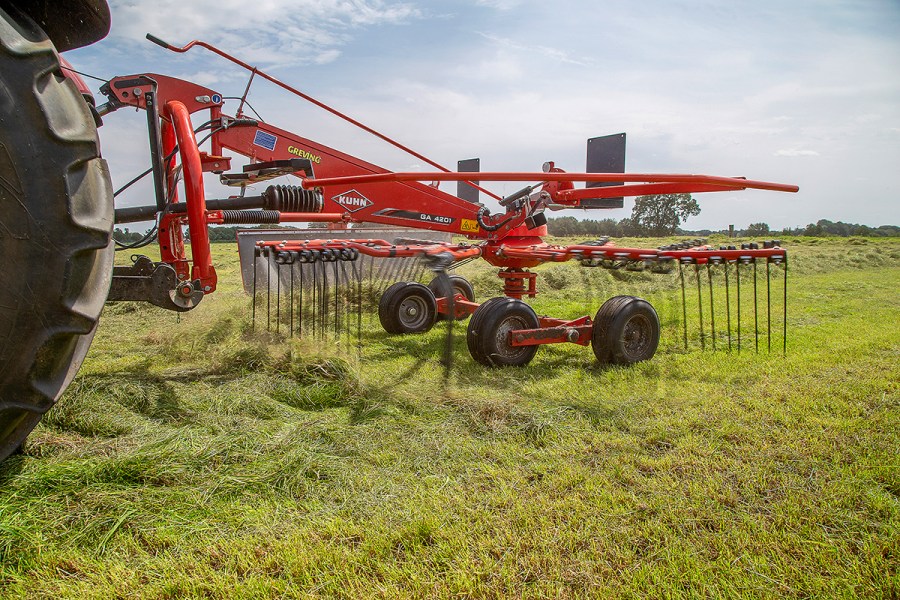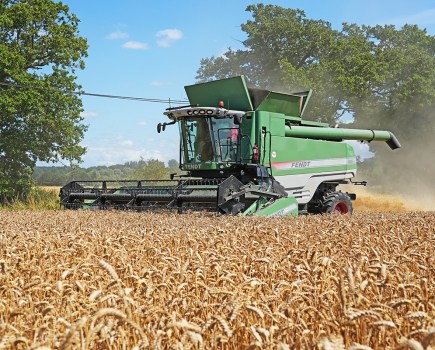Kuhn has presented a new generation of GA single-rotor rakes. We used the 4201 last year and were impressed.
KEEPING IT BRIEF
- The GA single-rotor rake from Kuhn is a new design.
- No quibbles with the quality of work or swath shape.
- The rake places the swath to the right side of the machine.
Single-rotor rakes are far from being a thing of the past with sales figures being relatively consistent — and not just for Kuhn. A good enough reason for us to take a look at Kuhn’s latest offering, which received an overhaul last year.
Called the GA, it comes in three models with rotor diameters from 2.90m to 3.40m. Our test machine was the middle model, the 4201, which has a rotor diameter of 3.20m and 11 tine arms.
A clean rake
The pins for the lower links are floating and on a Cat II spacing. Because the pto stub has been moved 32cm to the rear, there is no risk of the tractor wheel colliding with the pto in its stored position on the basic holder. Another benefit to the change in pto position is that the shaft doesn’t run at as steep an angle as it used to when the rake is raised. The hydraulic hoses and the plug for the lights have a neat storage spot on the GA’s headstock. The only real fly in the ointment is the parking stand, which suffers from a mismatched hole pattern when the machine is in work.
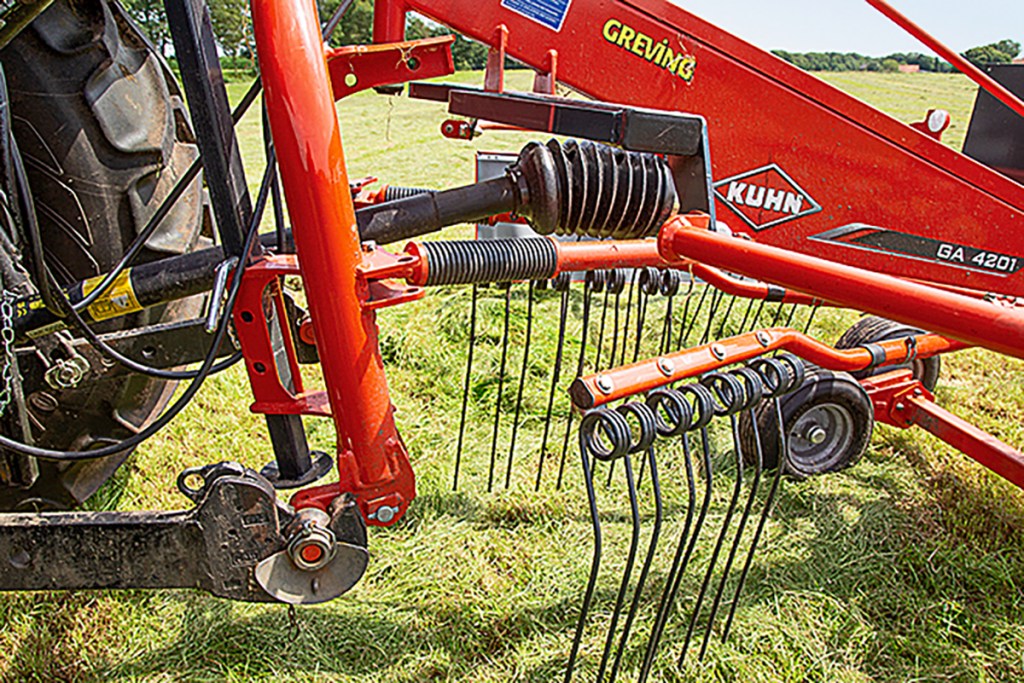
For an extra £865 you can operate the swath curtain and the guard rail hydraulically via the double-acting spool. It’s a great feature, but you still need to hop off and remove at least five tine arms before you can hit the road without being over 3.0m wide. The exemplary road lights including warning panels cost just under £425 extra, but we highly recommend the kit.
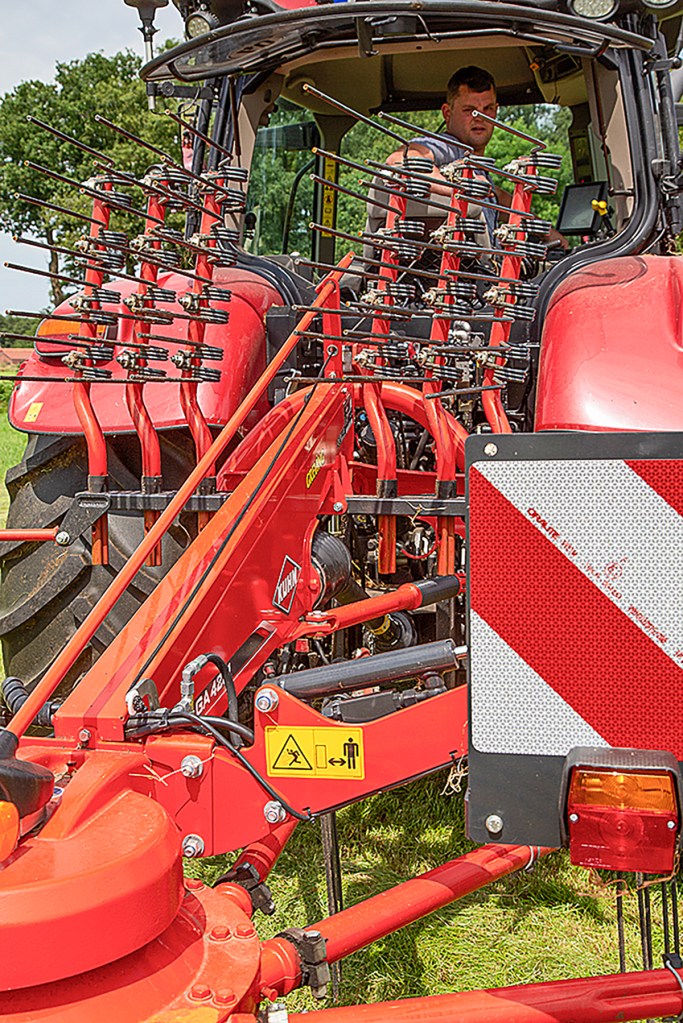
Working to the right
The pinion that drives the rotor is located under the large gear wheel. This means that the rotor turns to the right and places the swath on the right. This takes some getting used to, because you need to look to your left, especially on the outer run where you have to avoid fences or other obstacles.
Saying that, the rotor is protected against overload and the design is very robust, but it still doesn’t guarantee you’re not going to damage the arm if you hit something — even though the arm diameter has increased to 52mm instead of the usual 40mm.
The arm itself is connected to its bearing with a bolted clamp with roll pin. In a worst case scenario, this is the pre-machined break point so the more costly parts like the bell and cam track don’t get damaged.
Steep cam tracks
Kuhn also uses double-cranked arms on its single-rotor model. Just like in our test with the big four-rotor rake (profi 11/2024), the smaller GA pulls almost no material back out of the swath — very good. The steep cam track plays its part here, enabling the tines to lift very quickly and fly over the row.
As on its other rakes, Kuhn also opts for a completely enclosed and maintenance-free cam track on the GA. However, the bearings on the tine arms each have a grease nipple, but these only need greasing once a year.
Fitting and removing the arms is actually easy. One arm weighs just under 4kg and has to be inserted into the relevant storage slot on the linkage headstock. Frustratingly there aren’t enough slots for all 11 arms, which would make it easy to grease the arm couplings at the end of season so they didn’t rust over winter, making fitting/removal the following season that bit trickier. Once inserted into the profile tube, the arms are secured with plastic lynch pins. After using the rake for one season, we didn’t spot any signs of wear on the pin.
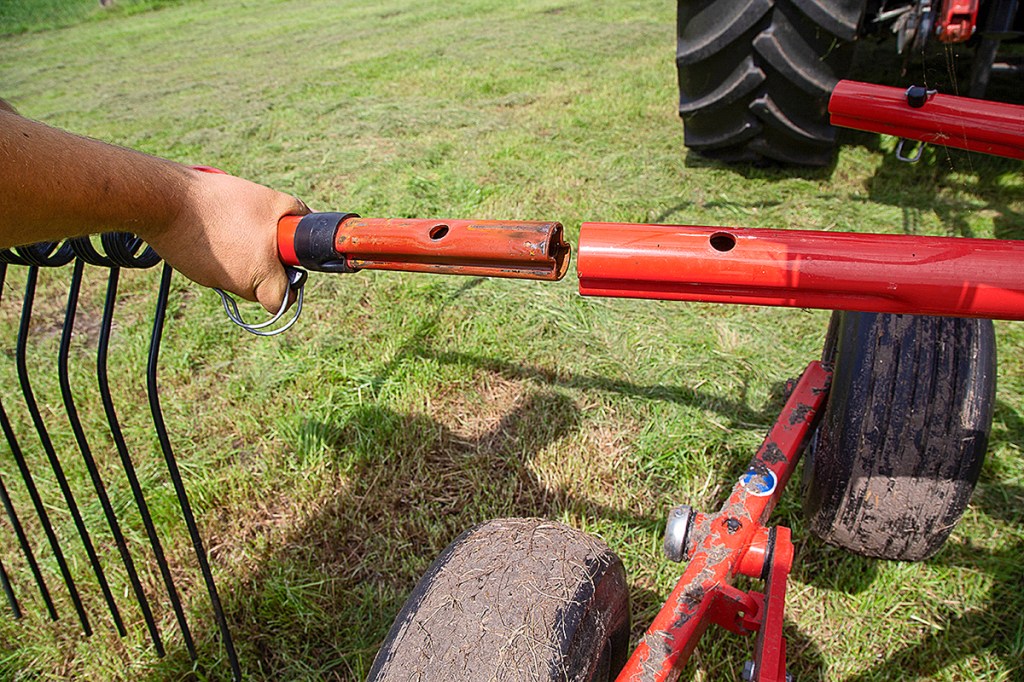

The angle of the rake is set once on the hole pattern on the chassis, whereas the working height is adjusted on a crank above the headstock. This is all simple, although we would appreciate a scale, as it would make it easier to change between the settings for straw and grass.
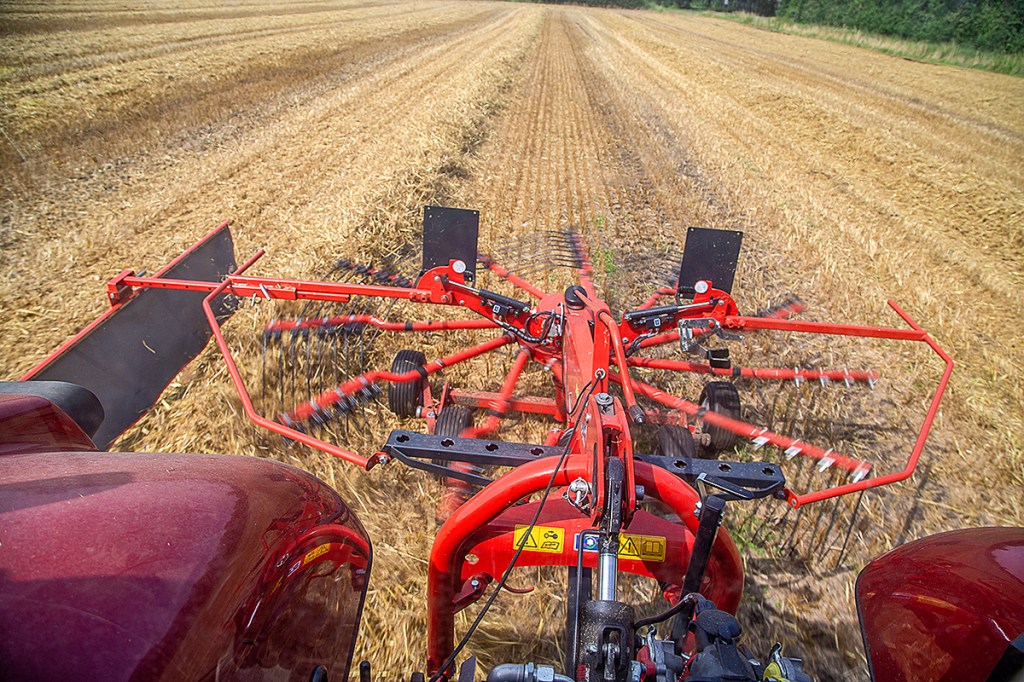
Clean and quiet
The work itself is excellent, and the tandem bogey axle certainly assists with smooth, quiet running (£660 option). At the headland, we noticed that the very low position of the link arms increases the lift-out height so it cleared big swaths, even those 40cm high rows. The lateral stabilisers, too, provide some welcome damping, and, when lifted out of work, even when on a curve, swing the rake into its straight position. This is where the optional hydraulic dampers, as on the bigger GA4401, are an advantage, as they stop the weight shifting. Speaking of curves, thanks to the newly designed three-point headstock, the rake can steer 24° to either side, which is great for bends and headland turns.
We hitched the rake to 50-120hp tractors. If you want to keep rowing several swaths into one, the tractor should ideally have a narrow track width. If not, the tractor ends up driving on part of the already formed row when making the most of the working width. Picking up such a swath is of course trickier than if you gather a fluffy swath that was delivered to the right-hand side.

Other details
- An alternative to the hydraulic folding curtain is a mechanical spring.
- We didn’t miss a front support wheel on the three-point headstock during the test.
- The practical turning stop for the tine arms moves up automatically as soon as the protective tubes and the curtain are lowered.
- The tine height is set relatively easily even when the rake is on the ground.
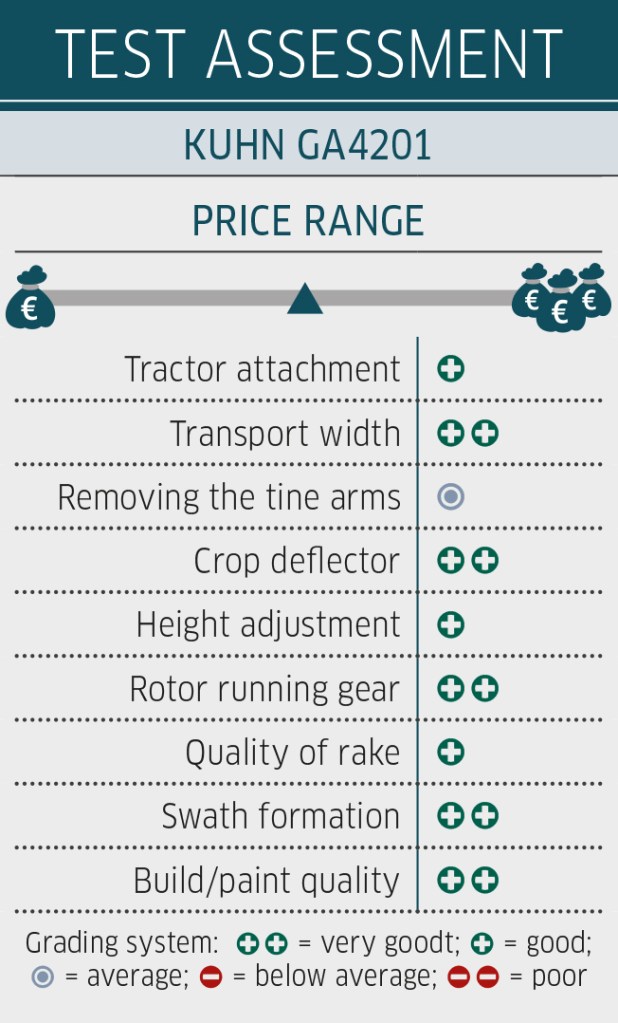

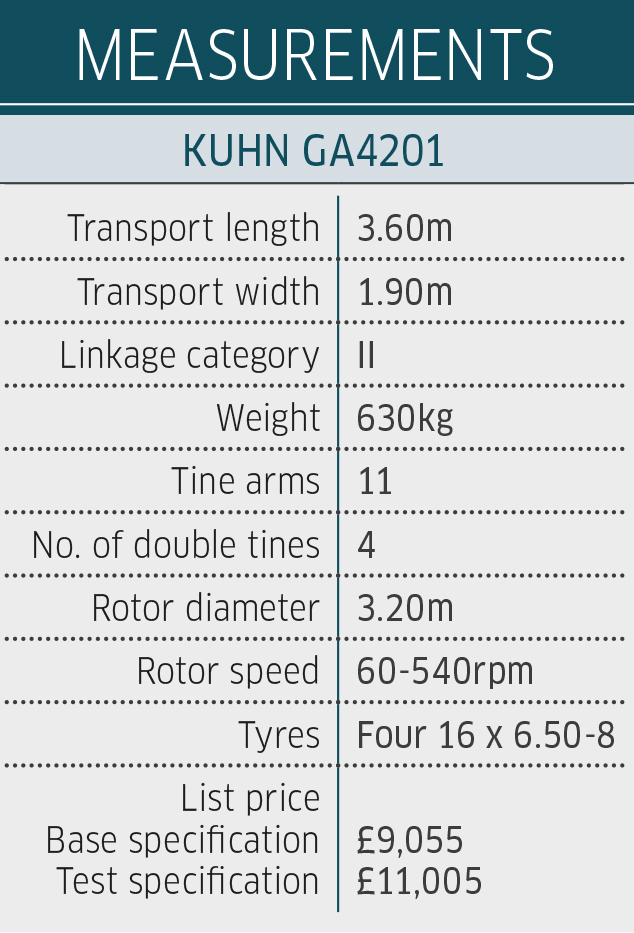
Summary
The Kuhn single-rotor rake does what it is supposed to do and does this really well. The quality of work and the smoothly running tandem axle are all excellent points on the French machine. The same applies to the impressive build quality.
The only criticism goes to the fiddly swath width adjuster and the awkward attachment of the tine arms, though these are far from major issues. In tested configuration, the list price of the GA4201 is about £11,000.
Tobias Bensing
For more up-to-date farming news click here and subscribe now to profi and save.

